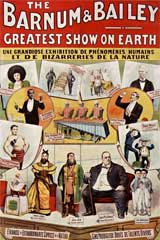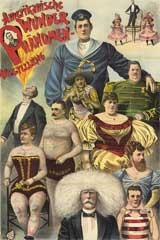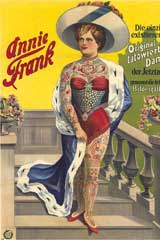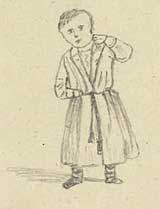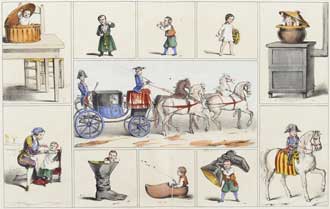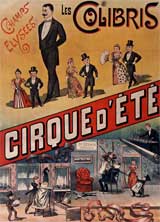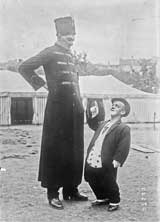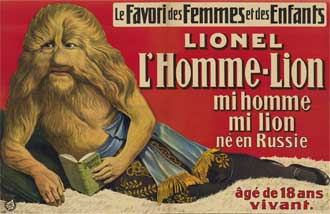The "phenomena"
by Pascal Jacob
As far back as we can go in the history of people and societies, curiosity and difference are implicitly linked. They take different forms and intensities according to the times and belong in turn to the sacred or profane sphere, but they are also closely associated with the fairground environment and, to a lesser extent, with the world of the circus.
Several Roman emperors, from Tiberius to Domitian, maintained many small people in their respective courts and a few centuries later, when Hernán Cortes entered Moctezuma's palace in Tenochtitlan in 1519, he discovered thousands of living creatures there, including a number of different human beings, smaller or larger than what Nature usually offered, gathered there to counterbalance the Emperor's perfection. This notion of otherness is essential to understand the public's enthusiasm for those who are called "phenomena" and whom Phineas Taylor Barnum will choose to rename "Prodigies of Nature". Skeleton Man, Lion Man, Bearded Woman, Calculating Prodigies, male and female Siamese, Giants, Colossi and Lilliputians became regular participants in exhibitions named "sideshow" by American entrepreneurs in the late 19th century, literally alternative presentations, under a special tent "beside" the large tent and the menagerie.
A small booklet published in February 1818, Précis historique sur Babet Schreier, surnommée la lilliputienne et notes sur quelques autres nains et naines célèbres, available in Paris from the Franconi and Barba brothers, reports an extraordinary success for an eight-year-old girl of German origin, very comfortable on stage, but especially of a tiny height. Twenty years later, Charles Sherwood Stratton was only four years old when Barnum first rented him from his parents: he too was very young and his doctors assured him that he would not grow up much... True to his reputation, after exhibiting General Washington's nanny and a Fijian "mermaid", Barnum emphatically transformed the child into General Tom Tom before taking him to Europe where he would become famous and make the fortune of his impresario. Phineas Taylor Barnum, self-proclaimed "Prince of Deception", remains in the collective imagination as a remarkable opportunist and a skilled "miracle worker", but he has probably done nothing more than capitalise on this paradoxical desire to be duped, with humour and effrontery.
There is undoubtedly a before and an after Barnum, as the principles of exhibition and communication seem to have been shaped to his satisfaction. Tom Pouce may still be the American impresario's greatest opportunity, but during his stay in Europe, he also took advantage of a few unforeseen opportunities to perfect his technique. Barnum spotted a particularly agile dwarf, Harvey Leach, whom he wrapped in fur and displayed, with some success, as an unknown half-man, half-monkey creature. The "What is it?" question which spreads over the multitude of illustrated posters stuck on the walls of the city is enough to attract crowds.
In Praise of Difference
If we refer to the oldest beliefs, the first giant in the history of humanity would be Adam since he is supposed to have reached a height of more than 41 metres, Eve being satisfied with 40 metres... A legendary precedent, but which perfectly symbolises how much a tall stature is likely to be a source of tales and curiosity. Tall men and women have always marked their time and although many were associated with a particular court, others have experienced the limelight by being exhibited in theatres or exhibitions. In 1664, a giant of German origin performed in London, as advertised in leaflets distributed in the city. Between the end of the 18th century and the beginning of the 20th, many male and female giants fascinated peoples and the most powerful, reviving myths and legends by their very presence. Blocker, Charles Byrne, Patrick O'Brien, Louis Frenz, Joachim Eleicegui, whose hands were cast by the famous Susse frères founders, Robert Hales, the Chinese Chang, Hugo, but also Catherine Bockner, Marianne or Clothilde Schneider have simply satisfied this sense of confusion induced by the difference that attracts the crowds. Above all, these giants were very much real, beautiful and elegant at times, capable of giving flesh and soul to the character of Gulliver, thus turning the spectators back into their own Lilliputian status…
It is this inversion of roles that motivates this immoderate taste for the excessive or the tiny, but always human. This propensity to play with difference has not totally disappeared from the fairgrounds: the Brothers Grim's Sideshow produced by Ken Harck still offers today a half-savant half-distant exhibition with stages decorated with red velvet, designed to recreate the luxury of a setting and where real prodigies of nature are presented, with their sheer presence reviving the tensions and fascination from the golden era of these types of exhibitions.
In 2003, the American firm HBO produced Carnivale, a series entirely developed on a daily basis to accompany a travelling troupe of phenomena. Translated into French under the title La Caravane de l'étrange, the two seasons plunge the viewer into a scrupulously reconstructed universe, an atmosphere marked by the social upheavals resulting from the 1929 crisis and where the travelling community acts as a fascinating social mirror. This series is part of an interesting symbolic lineage, from Tod Browning's Freaks to David Lynch's Elephant Man, remarkable productions that capture a form of difference at its source to better extol tolerance and respect. This sensitive understanding also permeates the work of Jeanne Mordoj and the Bal company, with L'éloge du poil, a show performed by a young bearded woman, a hairiness that she wears like a mask, a way of questioning gender and identity, the willingness to accept each other. A dimension that Le Palais des Découvertes by the Off company, created in 1993, explores with humour by inviting the audience to enter under a small tent cluttered with distorting mirrors and where the abnormal is embodied by a sculptural athlete who is regarded as the "shame of the family"…





